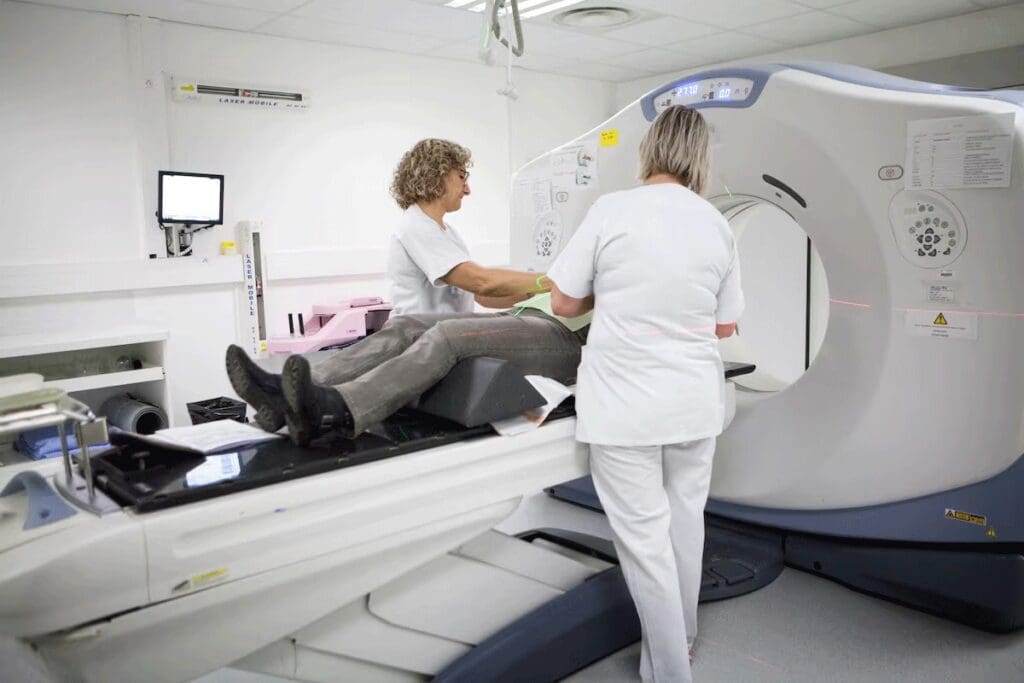Last Updated on November 27, 2025 by Bilal Hasdemir
Radiation therapy is a common treatment for cancer, used to cure the disease, prevent it from returning, or stop its growth. At Liv Hospital, patients can expect high standards of care throughout their radiotherapy journey.

The frequency and duration of radiotherapy vary based on the type, stage, and location of cancer, as well as individual patient needs. Typically, external radiotherapy is administered once a day, five days a week, over a period of one to eight weeks.
Understanding what happens during radiation therapy can ease uncertainty and make the treatment process less daunting. By knowing what to expect, patients can better prepare themselves for the journey ahead.
Key Takeaways
- Radiotherapy frequency and duration vary based on cancer type and patient needs.
- External radiotherapy is typically given once a day, five days a week.
- Treatment duration can range from one to eight weeks.
- Radiation therapy is used to cure cancer, prevent its return, or stop its growth.
- Liv Hospital provides high standards of care for radiotherapy patients.
Understanding Radiotherapy: A Comprehensive Overview
Radiotherapy, also known as radiation therapy, is a crucial treatment for various types of cancer. It involves the use of high-energy particles or waves to destroy or damage cancer cells, thereby preventing them from growing and dividing.
What Is Radiotherapy and How Does It Work?
Radiotherapy works by delivering radiation to the cancerous cells, which damages their DNA and prevents them from reproducing. This ultimately leads to the death of these cells. The goal of radiotherapy is to deliver a precise dose of radiation to the tumor while minimizing exposure to surrounding healthy tissues.
The process begins with a consultation with a radiation oncologist, who will determine the best course of treatment based on the type, stage, and location of the cancer, as well as the patient’s overall health.
Types of Radiotherapy Available Today
There are two main types of radiotherapy: external beam radiation therapy (EBRT) and internal radiation therapy.
External Beam Radiation Therapy (EBRT): This is the most common type of radiotherapy. EBRT uses a machine outside the body to focus radiation on the cancer. The machine is called a linear accelerator.
Internal Radiation Therapy: This involves placing a small amount of radioactive material inside the body. There are two forms of internal radiation therapy: brachytherapy, where the radioactive material is placed directly into or near the tumor, and systemic radiation therapy, where the radioactive material is swallowed or injected into the bloodstream.
| Type of Radiotherapy | Description | Application |
| External Beam Radiation Therapy (EBRT) | Uses a machine outside the body to focus radiation on the cancer. | The most common type, used for a wide range of cancers. |
| Internal Radiation Therapy | Involves placing radioactive material inside the body. | Used for specific types of cancer, such as prostate and cervical cancer. |
| Brachytherapy | A form of internal radiation therapy where radioactive material is placed directly into or near the tumor. | Effective for treating localized tumors. |
| Systemic Radiation Therapy | A form of internal radiation therapy where radioactive material is swallowed or injected into the bloodstream. | Used for cancers that have spread throughout the body. |
Understanding the different types of radiotherapy is essential for patients to make informed decisions about their cancer treatment. Each type has its benefits and is suited to different cases and stages of cancer.
How Often Can You Have Radiotherapy?
The frequency of radiotherapy sessions depends on several factors, including the type and stage of cancer. Radiotherapy is a localized treatment that targets specific areas of the body, and its frequency is determined based on the overall treatment plan designed by the healthcare team.

Standard Treatment Schedules
Most people receive daily radiation treatments, Monday through Friday, for a period of 5 to 8 weeks. This schedule allows for the total dose of radiation to be divided into smaller, manageable fractions, enhancing the treatment’s effectiveness while minimizing side effects.
The standard fractionation schedule is designed to balance the need to deliver a sufficient dose of radiation to the tumor with the need to protect surrounding healthy tissues.
Factors That Determine Treatment Frequency
Several factors influence how often radiotherapy is administered, including:
- The type and stage of cancer
- The overall health of the patient
- The specific goals of the treatment (curative vs. palliative)
- The total dose of radiation required to effectively treat the tumor
These factors are carefully considered by the healthcare team to determine the most appropriate treatment schedule for each patient.
Rest Days and Their Importance
Rest days are an integral part of radiotherapy treatment. They allow healthy tissues to recover from the effects of radiation, reducing the risk of side effects. The weekends off during a standard treatment schedule serve as rest days, giving normal tissues a chance to repair.
Rest days are crucial because they help in minimizing the damage to healthy cells, thereby reducing potential side effects and improving the patient’s quality of life during treatment.
The Duration of Radiotherapy Treatments
Understanding the duration of radiotherapy is crucial for patients to prepare for their treatment journey. Radiotherapy is a common cancer treatment that uses high-energy particles or waves to destroy or damage cancer cells.
The length of radiotherapy treatment varies significantly depending on the type and stage of cancer, as well as the treatment goals. Generally, radiotherapy can last anywhere from a few days to several weeks.
Typical Length of a Complete Treatment Course
A complete course of radiotherapy can vary significantly in duration. For some patients, treatment may be as short as a single session, while for others, it can extend over several weeks.
- Short-course radiotherapy: Some treatments are designed to be completed in a few sessions, often used for palliative care.
- Standard radiotherapy: Typically lasts between 4 to 6 weeks, with sessions scheduled daily, Monday through Friday.
- Long-term radiotherapy: In some cases, treatment can extend beyond 6 weeks, depending on the cancer type and response to treatment.
How Long Each Session Takes
Each radiotherapy session typically lasts between 15 and 30 minutes. While the actual radiation delivery may only take a few minutes, preparation and positioning can add to the overall time.
The session duration includes:
- Preparation and positioning
- Imaging to verify the treatment area
- Delivery of radiation
Variables That Affect Treatment Duration
Several factors can influence the duration of radiotherapy treatment, including:
- Type and stage of cancer: More advanced cancers may require longer treatment courses.
- Treatment goals: Palliative care may involve shorter treatment courses compared to curative treatments.
- Patient’s overall health: Patients with certain health conditions may require adjustments to their treatment schedule.
By understanding these factors, patients can better prepare for their radiotherapy journey and what to expect during their treatment.
Accelerated and Hypofractionated Radiotherapy Schedules
Accelerated and hypofractionated radiotherapy schedules represent a significant advancement in cancer treatment, offering patients shorter treatment durations without compromising efficacy. These innovative approaches are particularly beneficial for certain patient groups.
What Is Hypofractionated Radiotherapy?
Hypofractionated radiotherapy involves delivering higher doses of radiation in fewer fractions compared to conventional radiotherapy. This method can be as effective as traditional radiotherapy for specific types of cancer, with the added advantage of a shorter overall treatment time.
Key characteristics of hypofractionated radiotherapy include:
- Fewer treatment sessions
- Higher dose per fraction
- Shorter overall treatment time
Benefits of Shortened Treatment Schedules
The primary benefits of accelerated and hypofractionated radiotherapy schedules include reduced treatment time and potentially fewer side effects due to the lower total number of sessions. These benefits can significantly impact a patient’s quality of life during treatment.
| Benefit | Description |
| Reduced Treatment Time | Patients undergo fewer sessions, making the treatment process less lengthy. |
| Potential Reduction in Side Effects | Fewer sessions may lead to fewer side effects, improving the patient’s quality of life. |
| Increased Convenience | Shorter treatment schedules are more convenient for patients, especially those with busy lives or significant travel requirements. |

Who Qualifies for Accelerated Treatments
Not all patients are candidates for accelerated or hypofractionated radiotherapy. Eligibility is determined based on the type and stage of cancer, as well as the patient’s overall health. Early-stage cancers or specific cases where the tumor is well-defined are often considered suitable for these treatment approaches.
Factors influencing eligibility include:
- Type and stage of cancer
- Patient’s overall health and medical history
- Tumor characteristics
By understanding the benefits and eligibility criteria for accelerated and hypofractionated radiotherapy, patients and healthcare providers can make informed decisions about the most appropriate treatment plan.
Before Your First Radiotherapy Session: Preparation Steps
Radiotherapy preparation is a multi-step process designed to maximize treatment efficacy. Before the actual treatment begins, patients undergo several crucial steps to ensure that the radiotherapy is delivered accurately and safely.
Initial Consultation and Planning
The journey to radiotherapy starts with an initial consultation with a radiation oncologist. During this meeting, the doctor will discuss the patient’s diagnosis, the goals of the treatment, and the potential side effects. This consultation is vital for creating a personalized treatment plan.
The radiation oncologist will also explain how radiotherapy is performed and what the patient can expect during the treatment sessions. This information helps in reducing anxiety and preparing the patient mentally for the treatment.
Simulation and Mapping
After the initial consultation, the next step is simulation. Simulation involves measuring the body and marking the skin where the radiation will be delivered. This process is crucial for accurately targeting the tumor and minimizing exposure to surrounding healthy tissues.
During simulation, the patient is typically positioned on a table, and imaging technologies such as CT scans are used to map the treatment area. The radiation team then marks the skin with small tattoos or temporary markings to guide the delivery of radiation during subsequent treatment sessions.
Creating Your Treatment Plan
Following the simulation, the radiation oncologist and the medical physics team create a detailed treatment plan. This plan outlines the dose of radiation to be delivered, the number of treatment sessions, and the frequency of the sessions.
The treatment planning process involves sophisticated computer software that helps in calculating the optimal radiation dose distribution. The goal is to deliver a high enough dose to the tumor to control its growth while sparing as much surrounding healthy tissue as possible.
By the end of the preparation phase, the patient and the radiation team are well-prepared for the treatment sessions. The careful planning and preparation ensure that the radiotherapy is effective and that the patient is comfortable throughout the process.
What Happens During a Radiotherapy Treatment Session
A radiotherapy treatment session is a carefully planned process that involves precise technology and skilled professionals. During treatment, patients lie on a table, and the radiation machine delivers radiation beams to the tumor site.
Step-by-Step Through a Typical Session
Here’s what patients can expect during a typical radiotherapy session:
- Preparation: Patients are positioned on the treatment table, and immobilization devices are used to ensure they remain still.
- Alignment: The radiation therapists align the machine with the marks or tattoos on the patient’s skin, made during the simulation session.
- Radiation Delivery: The machine delivers radiation beams to the tumor site, making clicking and whirring noises as it moves.
- Monitoring: The treatment team monitors the session from another room, using cameras to ensure the patient’s safety and the accuracy of the treatment.
The Technology Behind Radiation Delivery
The technology used in radiotherapy is highly advanced, allowing for precise targeting of cancer cells while minimizing damage to surrounding healthy tissue. Modern radiation therapy machines, such as linear accelerators, can deliver radiation beams with high accuracy.
Key features of radiotherapy technology include:
- Image-guided radiotherapy (IGRT) uses imaging technologies like X-rays or CT scans to verify the position of the tumor before and during treatment.
- Intensity-modulated radiation therapy (IMRT) allows for the modulation of radiation beam intensity to conform to the shape of the tumor.
- Motion management techniques help account for tumor movement during treatment due to breathing or other factors.
Safety Measures During Treatment
Safety is a top priority during radiotherapy sessions. Several measures are in place to ensure patient safety and the effectiveness of the treatment:
- Quality assurance checks are performed regularly on the radiation therapy equipment.
- Patients are closely monitored during each session.
- The treatment team is composed of highly trained professionals, including radiation oncologists, medical physicists, and radiation therapists.
By understanding what happens during a radiotherapy treatment session, patients can better prepare themselves for the treatment process and feel more comfortable with the technology and procedures involved.
Life During Your Radiotherapy Course
Managing life during radiotherapy involves balancing treatment schedules, daily activities, and personal well-being. As you undergo treatment, it’s crucial to make necessary adjustments to maintain your quality of life.
Managing Your Daily Routine
One of the key aspects of life during radiotherapy is managing your daily routine effectively. This includes planning your day around treatment sessions, which can last anywhere from a few minutes to an hour. It’s essential to stay organized and ensure that you have enough rest.
Simple adjustments, such as waking up a bit earlier to avoid rushing, can make a significant difference. Additionally, maintaining a healthy diet and staying hydrated are vital for your overall well-being during this period.
Work and Activity Considerations
Many patients wonder if they can continue working or engaging in their usual activities during radiotherapy. The answer depends on your overall health, the type of work you do, and how you feel during treatment. Some people can continue with their normal activities with minimal adjustments, while others may need to reduce their workload or take more frequent breaks.
It’s also important to consider the physical demands of your job and discuss any concerns with your healthcare provider. They can offer guidance on whether you should continue working and how to manage your workload effectively.
Emotional and Physical Support Resources
Radiotherapy can be emotionally and physically challenging. Fortunately, there are various support resources available to help you cope. These include counseling services, support groups, and resources for managing side effects.
Connecting with others who are going through similar experiences can provide emotional comfort and practical advice. Don’t hesitate to reach out to your healthcare team for recommendations on available support services.
By leveraging these resources and making necessary adjustments to your daily routine, you can navigate your radiotherapy course more effectively and maintain your overall well-being.
Managing Side Effects Throughout Your Radiotherapy Course
Managing side effects is a crucial aspect of radiotherapy, ensuring that patients can undergo treatment with minimal discomfort. Radiotherapy can cause a range of side effects due to the damage it inflicts on cancer cells and the surrounding healthy tissue. Understanding these side effects and how to manage them is vital for a successful treatment outcome.
Common Side Effects and When They Typically Occur
Radiotherapy side effects can vary depending on the area of the body being treated, the dose of radiation, and individual patient factors. Common side effects include fatigue, skin reactions, and nausea. For instance, patients undergoing radiotherapy for head and neck cancers may experience mucositis, or inflammation of the mucous membranes, which can be painful and affect eating and swallowing.
According to the National Cancer Institute, side effects can occur during treatment, shortly after treatment, or even months to years later. Being aware of these potential side effects allows patients to prepare and take proactive steps to minimize their impact.
- Fatigue: Feeling tired or weak, which can be cumulative throughout the treatment course.
- Skin reactions: Ranging from redness to blistering, particularly in areas exposed to higher doses of radiation.
- Nausea and vomiting: More common when the treatment area includes the abdomen or when the patient has a history of motion sickness.
Strategies for Minimizing Discomfort
There are several strategies that can help minimize the discomfort associated with radiotherapy side effects. Maintaining good nutrition, staying hydrated, and getting plenty of rest are crucial. For skin reactions, gentle skin care practices, such as using mild soap and avoiding harsh products, can help alleviate symptoms.
“Patients should be encouraged to report any side effects to their healthcare team, as timely interventions can significantly improve their quality of life during and after radiotherapy.”
Additionally, patients can benefit from:
- Engaging in gentle exercises to combat fatigue.
- Using anti-nausea medications as prescribed by their healthcare provider.
- Practicing relaxation techniques, such as deep breathing or meditation, can help reduce stress.
When to Contact Your Healthcare Team
Patients need to know when to contact their healthcare team regarding side effects. Severe or persistent side effects, such as significant pain, difficulty swallowing, or severe nausea and vomiting, require immediate attention. Patients should not hesitate to reach out if they experience any concerning symptoms.
By being proactive and informed, patients can better manage the side effects of radiotherapy and improve their overall treatment experience. Regular communication with their healthcare team is key to addressing concerns and adjusting treatment plans as needed.
Conclusion: Navigating Your Radiotherapy Journey
Navigating your radiotherapy journey can be complex, but understanding the treatment process is key to managing it effectively. Radiotherapy sessions typically last between 15 to 30 minutes, with actual radiation exposure lasting only a few minutes.
External Beam Radiation Therapy (EBRT) is commonly given in daily sessions over several weeks, while advanced techniques like SRS and SBRT deliver radiation in fewer sessions. Regular follow-up appointments are crucial to monitor response to treatment and manage side effects.
By understanding how long radiotherapy takes and what to expect during treatment, patients can better prepare themselves for the journey ahead. Effective management of side effects and a strong support system play a significant role in navigating radiotherapy successfully.
FAQ
What is radiotherapy and how does it work?
Radiotherapy is a cancer treatment that uses high-energy radiation to destroy cancer cells or slow their growth. It works by damaging the DNA of cancer cells, making it impossible for them to multiply and grow.
How often are radiation treatments given?
Radiation treatments are typically given daily, Monday through Friday, with weekends off. However, the frequency of treatments can vary depending on the type of cancer, the stage of the disease, and the individual’s overall health.
How long does radiotherapy take?
The length of radiotherapy treatment varies depending on the type and stage of cancer, as well as the individual’s overall health. Treatment can last anywhere from a few days to several weeks or even months.
What happens during a radiotherapy treatment session?
During a radiotherapy treatment session, the patient lies on a table, and the radiation machine delivers radiation to the affected area. The treatment is typically painless and takes only a few minutes.
How is radiotherapy performed?
Radiotherapy is performed using a radiation machine that delivers high-energy radiation to the affected area. The machine is controlled by a computer, and the treatment is carefully planned and delivered by a team of radiation oncologists and therapists.
What are the different types of radiotherapy?
There are several types of radiotherapy, including external beam radiation therapy, internal radiation therapy (brachytherapy), and systemic radiation therapy. Each type of radiotherapy has its own benefits and is used to treat different types of cancer.
How is radiation therapy done?
Radiation therapy is done using a radiation machine that delivers high-energy radiation to the affected area. The treatment is carefully planned and delivered by a team of radiation oncologists and therapists.
Can you have radiotherapy more than once?
In some cases, patients may be able to have radiotherapy more than once, depending on the type and stage of cancer, as well as the individual’s overall health. However, this is determined on a case-by-case basis.
How long is a radiotherapy session?
A radiotherapy session typically takes only a few minutes, although the entire process, including preparation and positioning, may take longer.
What are the common side effects of radiotherapy?
Common side effects of radiotherapy include fatigue, skin reactions, and hair loss, among others. The specific side effects and their severity vary depending on the type and location of the radiation treatment.
How can I manage side effects during radiotherapy?
Managing side effects during radiotherapy involves a combination of self-care strategies, such as maintaining a healthy diet, staying hydrated, and getting plenty of rest, as well as using medications and other treatments as prescribed by your healthcare team.
References
- Mehta, S. R. (2011). Radiotherapy: Basic concepts and recent advances. Cancer Radiotherapy, 15(5), 285-296. https://pmc.ncbi.nlm.nih.gov/articles/PMC4920949/






